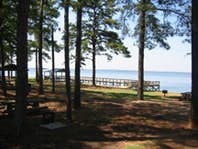San Diego Mayor Jerry Sanders and Councilmember Jim Madaffer helped the City of San Diego Water Department unveil new basins at the Alvarado Water Treatment Plant, located next to Lake Murray. With this ribbon cutting, these basins officially become a part of the existing water treatment system and add further capacity for flocculation and sedimentation, a particle separation process that helps to make drinking water.
“Completing these basins will help the city to continue providing safe and reliable drinking water for everyone in San Diego,” said Mayor Sanders. “This project is part of our ongoing effort to improve the overall efficiency of the city’s water treatment and distribution system.”
About 24,000 cubic yards of concrete were poured over a two-and-a-half year period to build the flocculation and sedimentation basins. At uniform depths of 15 ft, they can hold up to 8.4 million gal of water and increase the overall capacity of water treatment at the plant from 150 to 200 million gallons of water per day (mgd). As part of the water treatment system, these basins allow the flocculation, or chemical process, and sedimentation, the separation process, to occur. Design of the basins began in summer 2001 and construction followed in the spring of 2004. Malcolm Pirnie, Inc. headed the design of the basins. The construction management firm is CH2M Hill, and the general contractor is Archer Western Contractors. More than $28 million went towards construction with a total project budget of $54 million.
The basins are a part of Phase II of the Alvarado Water Treatment Plant Upgrade and Expansion project, which started in 1993 and is expected to be completed in 2013, depending on bond financing and state grants. The project will incorporate new equipment and technologies, three new reservoirs, the building of eight new filters, the rehabilitation of the existing filters, these new basins, an upgraded Operations Building, ozone disinfectant facilities, rehabilitation of the old sedimentation and flocculation basins, security upgrades, and new chemical storage and processing facilities. The capacity of the plant will reach 200 mgd, to help the plant keep up with the latest federal and state drinking water regulations. The increased capacity will also help meet the anticipated water demands projected for 2030 with the growth of population.
Source: City of San Diego


